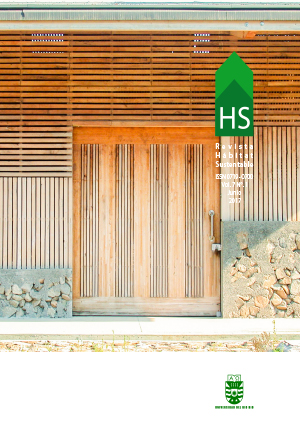Monitoreo energético y estrategias de RETROFIT para viviendas sociales en clima frío.
DOI:
https://doi.org/10.22320/07190700.2017.07.02.05Palabras clave:
evaluación higrotérmica, auditoria, simulación energética, simulación, , vivienda social, viviendas sociales, retrofitResumen
El presente trabajo aborda la aplicación de tecnologías y pautas para el reciclado masivo de viviendas urbanas representativas. Se evalúa aquí el comportamiento energético actual en una vivienda social “tipo” con un alto nivel de replicabilidad. Para ello, se cuantifica el potencial ahorro energético al aplicar diversas estrategias de mejoramiento de la envolvente edilicia que permitan arribar a valores admisibles de pérdidas térmicas, de acuerdo con la normativa argentina. Se describe la tecnología, el comportamiento térmico y energético de una vivienda perteneciente al barrio “645 Viviendas” (desarrollado por El Instituto de Planificación y Promoción de la Vivienda), ubicada en la ciudad de San Carlos de Bariloche, en la zona bioambiental IV, muy fría. Este barrio presenta una emergencia energética de gran magnitud, ya que no se encuentra conectado a la red de gas natural. Posteriormente, se examinan los resultados de la auditoria energética de 2016 y se muestra la simulación térmica realizada en Ecotect Analysis 2011, incorporando las condiciones reales de uso auditadas. Ajustado el modelo, se analizan 24 estrategias de mejoramiento de la envolvente térmica, posibilitando la identificación de las estrategias de mayor impacto en la reducción de la demanda energética.
Descargas
Citas
ALVARADO, Rodrigo García, et al. Desempeño ambiental de recintos habitacionales. Comparación de simulaciones, monitorización y percepción de residentes en seis viviendas de Concepción, Chile. Revista Tecnura, 2016, vol. 20, no 47, p. 71-84.
ANDERSEN, M., et al..(2016). Energy consumption and dwelling characteristics in households typology in The City Of S. C. De San Carlos De Bariloche, Argentina. Central Europe towards Sustainable Building 2016, Sustainable Renovation of Existing Building Stock, 25-32.
DÍAZ, C.; CZAJKOWSKI, J. Auditorías energéticas en viviendas de interés social en Río Grande, Tierra del fuego. AVERMA, 2006, vol. 10, p. 07.33-07.38.
DÍSCOLI, CARLOS A., et al. Pautas para el reciclado masivo de la envolvente edilicia residencial. Urbano, 2016, no 33.
FILIPPÍN, C.; LARSEN, S. Flores; GAY, E. Lopez. Energy improvement of a conventional dwelling in Argentina through thermal simulation. Renewable Energy, 2008, vol. 33, no 10, p. 2246-2257.
GARCÍA ALVARADO, Rodrigo; TREBILCOCK KELLY, Maureen; SOTO MUÑOZ, Jaime. Mejoramiento ambiental de viviendas urbanas unifamiliares en centro-sur de Chile. Arquitectura y Urbanismo, 2013, vol. 34, no 3, p. 39-48.
GARGANTA, María Laura; SAN JUAN, Gustavo. Análisis del comportamiento energético y ambiental de la producción de viviendas sociales en la provincia de Buenos Aires (2003-2011). Revista Avances en Energías Renovables y Medio Ambiente, 2012, vol. 14, p. 07-07.
GONZÁLEZ, A. D.; CRIVELLI, E.; GORTARI, S. Eficiencia en el uso del gas natural en viviendas unifamiliares de la ciudad de Bariloche. Avances en Energías Renovables y Medio Ambiente, 2006, vol. 10, p. 07.01-07.08.
MERCADO, V.; ESTEVES, A.; FILIPPÍN, C. Estrategias bioclimáticas en viviendas de índole social en Comodoro Rivadavia, Chubut, Argentina. AVERMA, 2008, vol. 12, p. 05.129-05.136.
Instituto Argentina de Normalización y Certificación (IRAM). Normas Técnicas Argentinas: 11601 (2004); 11603 (1996); 11604 (2004); 11605 (2002). Buenos Aires, Argentina.
Descargas
Publicado
Cómo citar
Número
Sección
Licencia
El contenido de los artículos que se publican en cada número de Hábitat Sustentable, es responsabilidad exclusiva de los autores y no representan necesariamente el pensamiento ni comprometen la opinión de la Universidad del Bío-Bío.
Los autores/as conservarán sus derechos de autor y garantizarán a la revista el derecho de primera publicación de su obra, el cuál estará simultáneamente sujeto a la Licencia de Reconocimiento de Creative Commons CC BY-SA que permite a otros compartir-copiar, transformar o crear nuevo material a partir de esta obra con fines no comerciales, siempre y cuando se reconozcan la autoría y la primera publicación en esta revista, y sus nuevas creaciones estén bajo una licencia con los mismos términos.











 Programa de Información Científica/Concurso Fondos de Publicación de Revistas Científicas 2018/ Proyecto Mejoramiento de Visibilidad de Revistas UBB (Código:FP180007)
Programa de Información Científica/Concurso Fondos de Publicación de Revistas Científicas 2018/ Proyecto Mejoramiento de Visibilidad de Revistas UBB (Código:FP180007) 





